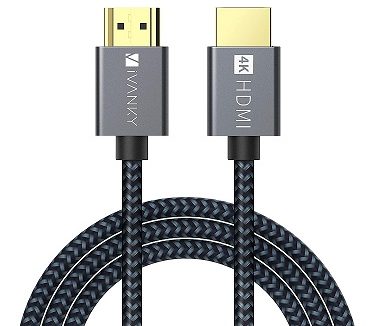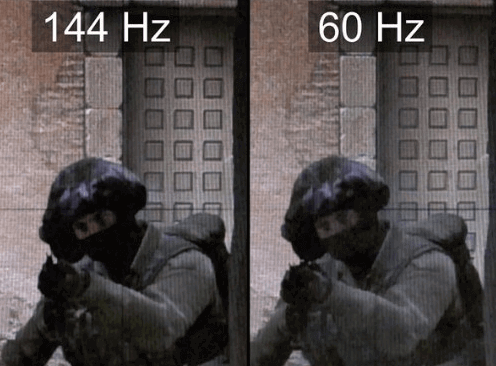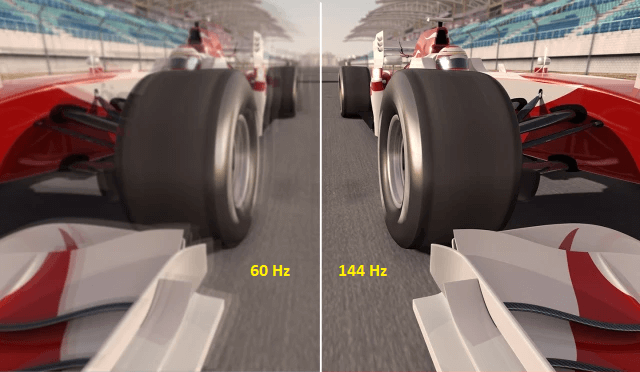The refresh rate available on gaming monitors is usually pretty high. But to be able to utilize your display’s high refresh rate, you need to make sure that it also supports proper input options that can allow such a high refresh rate at the given resolution. Generally, you might want a decent monitor that features both a high resolution and a high refresh rate. But, it would lack in terms of panel type and so on.
Today, we will check out whether an HDMI-supported display can offer a 144Hz refresh rate or not. Also, we will be looking into possible resolutions at which the HDMI connection can offer a high refresh rate. But before we dive into that, let’s understand the HDMI cable and the concept of refresh rate briefly.
Outline
ToggleAbout HDMI Cable
One of the most popular connectivity options which are available on almost every display device nowadays is the HDMI port. You will find an HDMI port on a TV, laptop, notebooks, consoles, monitors, and even on content streaming devices such as Amazon Fire TV stick and others. The HDMI stands for High Definition Multimedia Interface, and it was first available back in 2002. Since then, there have been a lot of upgrades in the HDMI interface, and newer generations have been released that are capable of much higher performance.
The best part about using an HDMI cable is that it is capable of transferring video as well as audio signals from source to display. Hence, if you are using an HDMI cable on your TV, you will need to plug in an additional audio cable as you can use the HDMI audio output option from the TV settings. The same goes for the monitors that have built-in speakers or audio jacks.
As the bandwidth capacity of HDMI cables is very high, you will be getting the best quality audio output which is very similar to the analog output option. The quality is significantly better compared to traditional RCA or even modern digital optical cables. Hence, an HDMI connection is the preferred choice for many users, whether we are talking about a TV or a desktop monitor connection.
About 144Hz Refresh Rate
You might be familiar with the term 144Hz if you are into gaming or video editing. The Hz unit in this term represents the refresh rate of a display panel. The refresh rate is basically the capability of a digital display to draw images in under a second. Hence, if your display has a 144Hz refresh rate, it is going to draw 144 images every second for the source of the video you have connected to it.
The 144Hz is mostly beneficial for gaming as more frames every second grants fluidity to the gameplay and allows users to consume more information every second compared to slower refresh rate monitors. Professional gamers can even tell the difference between a high refresh rate and a low refresh rate monitor by simply looking at a couple of seconds of gameplay. With a high refresh rate, you also feel more responsiveness in your system, which is a great deal for immersive gaming.
The current generation of graphic cards as well as consoles is powerful enough to render more than 144 frames every second for even the latest AAA game titles. Hence, a high refresh rate monitor or TV is necessary if you wish to truly take advantage of the expensive graphic cards or consoles.
But, more frames mean more data every second. Hence, your connectivity option must be capable of transferring a significant amount of data every second to your display to utilize the 144Hz refresh rate of the display. As we are considering the HDMI connectivity, let’s see if the HDMI connection supports 144Hz output or not.
Does HDMI Support 144Hz Refresh Rate?
In simple words, Yes. An HDMI connection does offer up to 144Hz refresh rate support for the displays that are capable of generating such a high number of images per second. Although, simply getting an HDMI port or cable is not enough to get a 144Hz output at your desired resolution. There are a lot of versions available for an HDMI connection that have varying bandwidth capacity.
Thus, each version is capable of providing 144Hz output at a different resolution. The standard HDMI 1.4 or higher connections available with laptops and TVs offer up to 144Hz connection at Full HD 1080p resolution. The HDMI versions that were released before the 1.4 version are not capable of a 144Hz refresh rate at a high resolution. We will be taking a look at various HDMI versions released up until now and their capabilities later in the article.
For now, let’s focus on the types of HDMI cables that can offer you up to a 144Hz refresh rate. Here are the most common types of HDMI ports and cables that support 144Hz refresh rate output if they are version 1.4 or higher.
- High-Speed HDMI Cable: The high-speed HDMI cables are the best option for gaming monitors if your monitor supports a 144Hz refresh rate. It can deliver a 144Hz signal to your display at a resolution that you desire up to 1080p Full HD. Hence, you can get a fluid gaming experience without compromising the video quality.
- Ultra High Speed HDMI Cable: The ultra-high HDMI cables can deliver up to 48 Gigabit data every second once connected to a source and supported display. Hence, this cable connection is ideal for video as well as audio connections. Keep in mind that ultra high-speed HDMI cables are slightly more expensive than standard cables.
- Micro and Mini HDMI cable: The micro HDMI cable connections are available on compact devices such as cameras and laptops. But, despite the compact size of the port, the micro, as well as mini HDMI cables, can transfer up to 144Hz video signals with up to Full HD 1080p resolution.
HDMI 144Hz Through The Generations
Now that you know which HDMI cables can offer you the 144Hz refresh rate support for your display, let’s take a look at all of the HDMI versions available in the market right now. It is crucial to know the exact version of HDMI connection provided on your display so that you can check out whether it supports 144Hz refresh signals at your desired resolution or not. Also, you need to know the HDMI version before buying an HDMI cable to avoid compatibility problems.
Here are various HDMI versions released so far and their respective capabilities.
- HDMI 1.0: Released back in 2002, the HDMI 1.0 quickly became one of the most popular display connectivity options and was quickly adopted by TV manufacturers and graphic card manufacturers. As it was the first iteration of HDMI, it could only support up to 4.95 Gbps bandwidth and 24-bit color depth. The maximum supported resolution for HDMI 1.0 was 1920×1200 pixels at 60Hz.
- HDMI 1.3: The HDMI 1.3 version brought a lot of upgrades to the existing HDMI design, which includes higher resolution support, deeper color gamut, and higher color accuracy. It also introduced the lip sync feature and surround sound option for the audio signals. There was a 10 Gbps bandwidth limit for HDMI 1.3 with 48-bit color depth and up to 1440p resolution support.
- HDMI 1.4: Coming to the most used HDMI version in the market right now, the HDMI 1.4 was released back in 2009 and is still being used as a standard option for many devices. It also has 10 Gbps bandwidth speed with 48-bit color bit support. But, it offers up to 2160p resolution at a 30Hz refresh rate and standard 1080p resolution output at 144Hz.
- HDMI 2.0: Next up, we have the HDMI version 2, which is a significant improvement over previous HDMI versions. There is up to 18 Gbps bandwidth capacity available via various iterations of HDMI 2.0 cables that offer up to 240Hz refresh rate at 1080p resolution. As for the 144Hz output, it can support that with a 1440p resolution.
- HDMI 2.1: The HDMI 2.1 is the latest version of HDMI released back in 2017. Still, it is slowly being adopted as the standard display option for HDMI as it offers 48 Gbps bandwidth capacity, which is more than double of its predecessors. The maximum supported resolution with HDMI 2.1 cable is 4320p at 50Hz, and it can support 144Hz output at 2160p resolution.
What Do You Need For HDMI 144Hz?
The requirement of an HDMI port changes according to the resolution you wish to keep your display at and the refresh rate you need at the output. After going through various types and versions of HDMI cables available in the market, you must have chosen the right HDMI port for your application. If not, take a look at the following table to get a clear idea.
| Required Resolution And Refresh Rate | Supported HDMI Version | Application |
| 1080p at 60Hz | HDMI 1.0 or higher | Standard display output for movies and 60 FPS gaming |
| 1080p at 144Hz | HDMI 1.4 or higher | Competitive gaming and content creation |
| 1440p at 144Hz | HDMI 2.0 or higher | High-resolution gaming and overall smooth viewing experience for high-resolution assets |
| 2160p at 144Hz | HDMI 2.1 or higher | High refresh rate 4K gaming as well as console gaming with latest consoles |
| 4320p at 50Hz | HDMI 2.1 or higher | The best output resolution for 8K games and videos |
Keep in mind that almost all HDMI versions are completely backward compatible. Hence, an HDMI cable that supports a 144Hz signal can be connected to either HDMI 1.3, HDMI 1.4, or even HDMI 2.0 ports without any problem. Also, you will be getting a higher refresh rate at lower resolutions with every consecutive generation of HDMI ports.
Conclusion
If you are confused about whether an HDMI cable supports a 144Hz refresh rate or not, we will recommend you carefully take a look at all of the information provided in our article today. Not only will you find whether an HDMI cable supports a 144Hz refresh rate or not, but you will also find out the capabilities of various HDMI versions and a suitable HDMI version for your application.
A standard HDMI 1.4 supported display should be a great choice for competitive gaming as it supports a 144Hz refresh rate at 1080p. But if you are planning to buy a Play station 5 or an Xbox Series X, you should get a monitor or a TV with HDMI 2.1 port.




